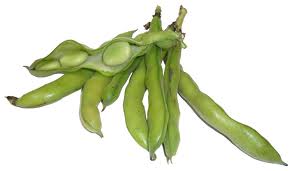 Fava beans, also known as broad beans, are a wonderful tasting legume which grows in large pods containing five or six beans. The pods can grow to eight or nine inches in length, and are known for the fuzzy lining which protects the growing beans. In addition to its unique pod, fava beans include an additional skin which must be removed before eating. While it takes a lot of work to get to these delicious beans, the effort and time it takes to clean fava beans is well worth the wait.
Fava beans, also known as broad beans, are a wonderful tasting legume which grows in large pods containing five or six beans. The pods can grow to eight or nine inches in length, and are known for the fuzzy lining which protects the growing beans. In addition to its unique pod, fava beans include an additional skin which must be removed before eating. While it takes a lot of work to get to these delicious beans, the effort and time it takes to clean fava beans is well worth the wait.
Fava beans were first cultivated in the Near East during the bronze age. Due to their dietary qualities, they quickly became popular, making their way from along with Spice Route to Europe. While fava beans continue to be popular in Asian and European cuisines, there popularity in the United States is just beginning to take shape. Fava beans have both a savory and unsavory side in popular culture. As the main ingredient in 12th night cake, these precious pods are popular among Christians when celebrating the Twelve Nights of Christmas. Hollywood, and Hanibal Lechter, made the beans popular through the movie Silence of the Lambs.
While delicious, there is a rare condition known as favism, which can produce an allergic reaction among people of Mediterranean descent. Also, people who take certain medications, such as MAOI inhibitors, should consult a physician before partaking in fava bean consumption.
Key Nutrients
Fava Beans are a great source of protein, fiber, iron and calcium. Fava beans contain a high amount of unsaturated fat, making them a healthy choice for heart healthy diets.
Health Benefits
Iron –Iron, found in red blood cells, is an integral part of hemoglobin. Hemoglobin carries oxygen from the lungs to the cells. Iron is an essential component of many enzymes necessary for various chemical reactions in the body.
Calcium – Calcium is an important mineral for bone and teeth growth and maintenance. It is also an important mineral in terms of cardiovascular function.
Dietary Fiber – Dietary Fiber stimulates digestion and peristalsis, helping to relieve indigestion and constipation problems.
Season
Fava Beans start appearing in markets during the late spring and early summer months. By the end of July, this delectable bean will not be seen until next year.
Nutrition Information
Per 100 grams:
Calories (cKal):
Protein (grams):
Total Fat (grams):
Carbohydrates (grams):
Fiber (grams):
Buying and Storing
Once you purchase your fava beans, you can keep them in a cool dry place for up to one week. From here, remove the outer shell to expose the inner beans. Once shelled, store the fava beans in your refrigerator for three to five days. When purchasing these delicious beans from the store, make sure the beans are not rotting on the outside or contain mold. Once you remove the shell, make sure the beans appear green and not yellow. If they are yellow, throw the bean out, but you can salvage the remaining beans in a pod which are green in color.
Best Way to Add to Diet
Fava beans can be added to your diet in a number of ways. First, make sure to remove the inner seed by blanching the beans in water for thirty seconds or so. Plunge the beans into cold water, then remove the inner shell. From here, you can add the favas to a salad, sautéed dish or make a puree.

 Not Sure What Healthy Foods To Eat?
Not Sure What Healthy Foods To Eat? This week we take a look at one of my favorite healthy foods...the mighty Avocado.
This week we take a look at one of my favorite healthy foods...the mighty Avocado.
No comments yet.